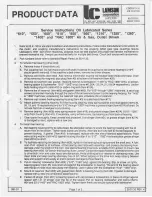
5
Typical Applications
How to Strip Paint
In addition to many other appli-
cations, stripping paint has
become a popular use for
your Masterflow Heat Blower.
Because of its higher power
and airflow ratings many
professional restoration and
renovation contractors recog-
nize it as the tool of choice for
tough paint stripping jobs.
We recommend using only
the Model AH-501 (120V),
AH-501C (120V, in Canada) or
the Model AH-502 (220/240V)
for professional paint stripping
applications.
Paint Stripping Safety
Instructions
1) WARNING: With a heat
gun, as with all other heat
tools, keep a fire extin-
guisher handy and observe
all sensible fire precautions.
1)
We do not recommend
using this heat gun on hol-
low surfaces such as out-
door siding, walls, soffits,
panels and partitions, etc.
These areas often contain
flammable materials such
as dust, wood chips, insula-
tion, rodent nests and other
debris which could acciden-
tally ignite.
1)
Your heat gun is best used
for stripping paint from solid
woodwork with ins and outs,
such as solid interior trim,
mouldings, turnings, doors,
balusters and porch trim, etc.
1)
When stripping paint, always
keep the heat gun moving
in a continuous back and
forth motion. Stopping or
pausing too long in one spot
could ignite the surface you
are working on or the area
behind it.
2) Do not breathe or swallow
lead based paint in any form.
Many old homes and other
buildings contain lead based
paint. Dust, scrapings,
residues and vapors of lead
based paint are extremely
poisonous. Prevent possible
lead poisoning when strip-
ping this type of paint by
using adequate ventilation
(such as a window fan in
the exhaust mode), and
keeping a clean work area.
When dust or vapors are
present, use a respirator
designed to filter lead. Move
work outside when possible.
1)
Failure to follow adequate
safety precautions when
working with lead based
paint could result in lead
poisoning. See our Paint
Stripping instructions for
more information.
3) Keep away from chemical
paint strippers which can
ignite or release harmful
vapors.
4) Use adequate ventilation
(such as a window fan in
the exhaust mode) and
keep your work area clean.
5) Wear gloves and safety
glasses at all times.
6) Keep a fully charged fire
extinguisher close at hand.
7) Stay alert, watch what you
are doing, and use common
sense.
To Operate Heat Blower
1) Plug heat blower into prop-
erly rated outlet.
2) Move toggle switch to “Hot”
position. Heat blower will
come up to full operating
temperature in approxi-
mately two minutes.
3) Adjustable stand is pro-
vided to allow nozzle to be
rotated from almost hori-
zontal to vertical position.
Operating Instructions
(cont’d)
4) To turn heat blower off
after use, move switch to
“Cold” position. Run on
cold for approximately
three minutes. This will
allow the heat blower to
cool down and the nozzle
to become cool to the
touch.
5) Move switch to "Off"
position.
When heat blower is used in
an enclosed container, such as
a shrink tunnel or special
enclosure, ambient air must be
allowed to pass into the heat
blower and there must be an
outlet of equal size for the
heated air to pass out of the
enclosure also. Total enclosure
will cause damage or possible
failure to the heat blower due
to the extreme heat generated.






































